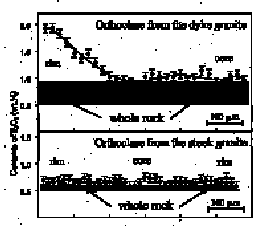
Generally speaking, phosphorus enrichment in granitic melts may result from three processes: (1) fractional crystallization, (2) liquid immiscibility, or (3) postmagmatic metasomatism with element redistribution. The aim of the present study is to assess the potential role for each of these processes in the generation of an extremely P-enriched Variscan rare metal-bearing granite suite from western Krus˜né hory (Erzgebirge) Mts.
The Podlesí granite has intruded lower Paleozoic phyllites, forming a stock 300 m across (Breiter and Seltmann, 1995). The studied drill core consists of phyllites (at the depth 0-50 m), albite-topaz-zinnwaldite granite ("stock granite", on average 0.5 % P2O5, at 50-310 m) cut by about ten subhorizontal dykes, 0.2-7 m thick, of "dyke granite" (up to 2 % P2O5, at 70-110 m). Thin subhorizontal pegmatite dykes, up to 0.1-0.5 m thick, penetrate both granite types.
Alkali feldspars from all granitoid types are characterized by high contents of P2O5 that is incorporated into feldspar structure by the Al3+ + P5+ = Si4+ + Si4+ substitution (Fry´da and Breiter, 1995). Orthoclase from the stock granite does not show any zonality in phosphorus distribution and its P content equals to that of the whole rock (Fig. 1). On the other hand, orthoclase from the dyke granite shows a distinct zonality, with rims of crystals enriched in P. As the KDP fluid/melt = 0.2 at 650°C (London, 1995), the P-rich rims of orthoclase crystals in the dyke suite appear to have crystallized from the residual melt, while the overlying stock granite was affected only by relatively P-poor fluids.
Microthermometric study of melt inclusions provided data on the solidus temperature (650-520°C), viscosity of the melt (ca. 1000 Pa.s at 800°C), and a total volatile concentration of the magma (up to 10 eq.-wt.% H2O).
Microprobe analyses of melt inclusions confirmed the expected high F (2-6 wt.% F) as well as P2O5 contents in some of the samples. Evidence for liquid immiscibility of F-P-Fe-rich and Si-Al-rich melts was also found.
Whole-rock chemical data showed homogeneous distribution of all studied mobille elements (Li, Rb, Cs, F, P, U, Na and K) throughout the granite stock, apart from in the vicinity of the dyke suite. The elements Sn and W are concentrated in the stock granite, Nb and Ta in the dyke granite and pegmatite.
The magmatic system of the Podlesí stock is an outstanding example of processes associated with the transition from magmatic to hydrothermal stages in the development of rare-metal granites. The evolution of the crystallizing melt from near-equilibrium to disequilibrium conditions is characterized by the interaction between melt, crystals and highly reactive aqueous fluids separated from the melt. The observed phosphorus enrichment in the rims of the orthoclase crystals is interpreted to result from the crystallization of these rims following fluid separation from the melt.
Breiter, K.& Seltmann, R., Third biennial SGA meeting Prague. Excursion guide. 1-197 (CGS Prague, 1995).
Fry´da, J.& Breiter, K., Terra Nova 7, 315-320 (1995).
London, D. in Magmas, fluids and ore deposits. (ed. Thompson, J.F.H.) 175-202 (MAC short courses 23, Victoria, 1995).
Fig. 1: Phosphorus content in orthoclase from Podlesí.